 |
|

|
 |
TABLE of CONTENTS
 |
MnDOT kicks off 2014 construction season April 3 |
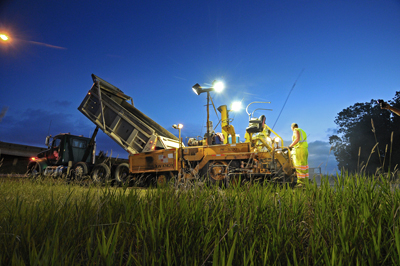
The 2014 road construction and maintenance season officially kicks off April 3 with a news conference in St. Paul. Photo by David Gonzalez |
Sure, northwestern Minnesota is digging out from the March 31 blizzard that dumped a reported 18 inches of new snow and closed a number of roads, including Hwy 1 between Oslo and Warren, and Hwy 2 from East Grand Forks to Crookston. And true, parts of the state are bracing themselves for additional heavy snow that’s predicted to hit the Upper Midwest on Thursday.
But, technically, it’s spring and that can mean only one other thing: the start of the road construction and maintenance season.
MnDOT will hold its annual statewide news conference April 3 to announce the 2014 state highway construction program. This year’s work includes hundreds of road and bridge projects, as well as projects that will improve Greater Minnesota transit centers, railroad crossing safety, seawalls and docks, and regional airports.
In St. Paul, Commissioner Charlie Zelle and Deputy Commissioner/Chief Engineer Sue Mulvilhill will talk about MnDOT’s overall program and transportation goals for 2014, while Tom O’Keefe, Metro District program delivery director, will address what motorists can expect on the Twin Cities area roadways this year. Lt. Eric Roeske, Minnesota State Patrol, will also be on hand to provide safety messages for the driving public.
District staff and their local news media will participate in the news conference via live-streaming on the Internet.
Specifics about this year’s statewide construction program will be posted to MnDOT’s website, www.mndot.gov/construction, after the 10 a.m. news conference. And, watch for project updates in Newsline throughout the season ahead.
|
 |
|

|
 |
TABLE of CONTENTS
 |
Flume research simulates Red River flooding to test road protections |
By Shannon Fiecke, Research Services & Library Flooding in the Red River Valley is an almost annual occurrence, and the cost to roads, property and lives is huge.
Residents in the little town of Oslo joke that Hwy 1 gets torn up year after year, only to be rebuilt in time for the next year’s flood. Oslo becomes an island whenever the roads close.
While not much can be done to prevent swollen farm fields from overflowing, what if a road embankment itself could be bolstered to prevent physical damage to the underlying structure of the road?
“We can’t just raise the road because it would create backwater upstream,” explained J.T. Anderson, assistant District 2 engineer. “Our best bet is to let the water over-top the road and try to protect the road when it does.”
|
Researchers have built a flume at the University of Minnesota's St. Anthony Falls Laboratory to test different erosion control methods on a simulated road shoulder. Video courtesy University of Minnesota |
Researchers built a flume inside the University of Minnesota’s St. Anthony Falls Laboratory to test six methods of embankment protection specific to the needs of towns like Oslo.
“It is not uncommon for one over-topping site to have a half-mile long stretch of road being damaged,” said Craig Taylor, university research engineer. “One road being protected should cover the costs of the study and deploying the erosion control product for that road.”
Nationally, research of this kind has mostly been restricted to high-intensity flooding.
“In those really high-depth, short duration events, you can only protect an embankment with concrete and boulders,” Taylor said. “With longer duration, low-depth floods, we may be able to protect roads with soft armoring, like reinforced vegetation.”
The damage in northern Minnesota has been the worst on east-west roads, where the river flow runs perpendicular to the center of the road, causing the road to act like a dam and the water to jump at the edges.
“It eventually eats through that road embankment and makes the road collapse,” Anderson explained.
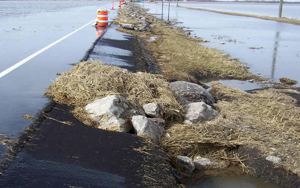
The damage from flooding was less in 2010 after engineers added rocks to the side of Hwy 9, near Ada. Photo Photo courtesy of District 2 |
Researchers will examine how a cross-section of a road holds up under various erosion control methods at different levels and speeds of water-flow.
One test will be to slow the flow of water by covering the road shoulder with a rubberized membrane and temporary water-filled tubes.
Permanent schemes, such as turf reinforcement mats and rocks, will also be tested.
“These methods have been deployed in the field, but you never really know under which conditions they survived or failed,” Taylor said.
In the Red River Valley, MnDOT engineers tried a combination of vegetation and boulders, as well as concrete blocks covered with topsoil, to protect highways. Flattening a slope is another option.
“I expect that a single erosion protection technique will not cover every situation our road embankments may be exposed to at any given location,” Anderson said. ”Rather, I expect we would look at using several different techniques in concert to develop an effective erosion protection system for the expected velocities.” |
 |
|

|
 |
TABLE of CONTENTS
 |
Sustainability plan makes progress toward energy, waste, water efficiency |
|
By Sue Roe Every day, MnDOT employees contribute to energy savings, waste reduction and water conservation efforts. It’s those everyday practices that help the agency’s sustainability plan produce results.
“The plan not only supports MnDOT’s Wildly Important Goal of enhancing financial effectiveness by making wise business decisions, but it helps us use sustainable solutions compatible with our natural environment,” said Marilyn Jordahl Larson, Office of Environmental Stewardship.
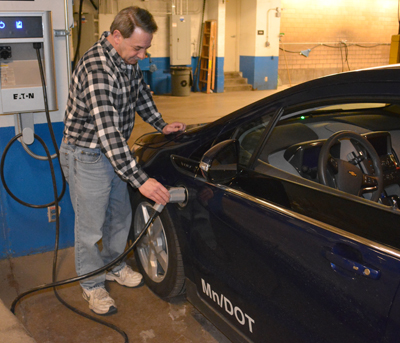
Tom Tufenk, lead worker in the motor pool, recharges one of MnDOT’s electric vehicle cars at the EV charging station. The electric vehicles are flex fuel vehicles, meaning they can run on electricity or a blend of up to 85 percent ethanol. The use of alternative fuel reduces air pollution and petroleum fuel consumption.Photo by Sue Roe |
The plan was directed by Gov. Mark Dayton’s 2011 executive order to strengthen state agency environmental, energy and transportation sustainability. See the state’s sustainability plan.
Working behind the scenes at MnDOT is the sustainability working group, a 30-member group charged with managing the plan and communicating its goals and achievements. The group was started by Lynn Clarkowski, Office of Environmental Stewardship. She and Jordahl Larson lead the group.
“MnDOT’s first sustainability plan was completed in 2010. In 2013, the plan was updated and we formed the working group to support MnDOT’s efforts and to assist with managing reporting and compliance,” Jordahl Larson said. “There’s a lot of effort that goes on behind every one of our 26 sustainability goals.”
The sustainability plan contains six target areas:
- Reduce air pollution
- Reduce energy usage
- Reduce petroleum fuels
- Reduce water consumption
- Minimize solid waste and prevent pollution
- Increase purchase and use of environmentally preferable products and services
“The 26 goals addressed in the six target areas impact every employee, from administration to operations to construction,” Jordahl Larson said.
Each target area has specific tasks, metrics for progress and timelines. Jordahl Larson said each state agency is allowed to decide many of its own tasks and targets.
“Some targets are mandated in the executive order, such as eliminating the purchase of products that contain triclosan such as hand soap, dishwashing and laundry products," she said. "Others are mandated by Minnesota statutes, while others we are allowed to set our own targets."
Goals such as defaulting agency printers to black and white duplex printing and buying multi-function devices with Energy Star efficiency ratings all reduce solid waste, save energy and save toner cartridge costs. An assessment of printers in Central Office led to replacing them with multi-functional machines that fax, copy, scan, and print.
“Desktop printers are a cheap piece of equipment, but when you factor in the cost of a toner cartridge, it’s actually very expensive to operate,” said Judy Blitz, a working group member. “We changed some machines right away and will replace others as needed. Some of the districts are now doing assessments too.”
MnDOT purchases the highest post-consumer recycled paper practicable, which falls into the environmentally preferable products and services target area. Craig Gardner, who is in charge of that task, said from 2009 to 2012, 99.7 percent of the paper purchased was 30 percent or greater post-consumer recycled content.
“It’s complicated finding paper products that are recyclable and finding the percentage that actually works in all our machines,” he said.
Seven MnDOT facilities contribute to greenhouse gas emissions reduction and sustainable energy efficiency by using geothermal heating and cooling systems. All state-owned buildings track energy usage through a benchmark reporting program. A MnDOT facility in Slayton, Minn., is piloting a wind turbine for energy generation.
Using alternative fuels, when practical, purchasing job-capable flex fuel vehicles when replacement cycles occur and using more technology for meetings to reduce fleet use reduces air pollution and petroleum fuel consumption.
“A total of 249 eligible diesel vehicles were retrofit with particulate emission controls. We’ve purchased alternative fuel vehicles including two compressed natural gas trucks, a hybrid electric aerial truck and 12 new tow plows. Each new tow plow takes one truck off the road,” said Robert Ellingsworth, fleet manager.
All of MnDOT’s diesel fleet is capable of burning a cleaner diesel fuel blend and more than half of MnDOT’s light duty fleet is capable of burning E85 fuel, he added.
MnDOT also works with international partners to determine the impact of rolling resistance and roughness on vehicle fuel economy. Smooth roads save money and reduce emissions, Jordahl Larson said.
The sustainability working group continues to work on ways to use MnDOT resources wisely while considering future needs.
“This is just the beginning. We’re incrementally working on our goals,” Jordahl Larson said. “Small behavioral changes, such as powering down computer monitors, turning off lights and taking the stairs add up to measurable energy savings. It’s the right thing to do for business, the environment and for future generations. We’re asking everyone to be more aware of the daily choices they make to minimize energy use, waste and emissions because the little things do add up to a more much sustainable future.”
Anyone who is interested in helping with sustainability efforts can contact Jordahl Larson. |
 |
|

|
 |
TABLE of CONTENTS
 |
Annual performance report shows high marks in reliability, improved road and bridge conditions |
By Laurie Ryan, Office of Customer Relations
This week MnDOT released its fifth Annual Transportation Performance Report that describes trends in the condition and service levels provided by Minnesota’s transportation systems.
“This report reflects the returns of past, present and near-term investment in transportation,” said Commissioner Charlie Zelle.
Based on 2012 data, the report shows that highway and bridge condition, although not quite achieving MnDOT’s statewide targets, was better in 2012 than in 2011. It also projects progress improvements as MnDOT continues its Better Roads for a Better Minnesota (paving) initiative and completes remaining bridge projects funded through the state’s 2008 Chapter 152 Bridge Bonding Program. Those projects include the U.S. 52 Lafayette Bridge in St. Paul, the U.S. 61 bridge in Hastings and the Interstate 90 Dresbach bridge near La Crescent, Minn.
The challenge, Zelle noted, is that these are limited, one-time investment programs, not the sustainable, long-term funding needed to plan and invest for future transportation needs.
“We have the nation’s fifth-largest highway system, with more than 140,000 miles of state, county and local roads, and more than 20,000 bridges. Our system is aging and is very costly just to maintain. Fifty percent of our state highway pavements alone are 50 years old, and 35 percent of our bridges are more than 50 years old,” he said.
Without additional, long-term funding MnDOT reports that its needs will significantly outpace existing revenue sources over the next 20 years – the $12 billion state highway and bridge gap projected in 2013 by the Minnesota 20-year State Highway Investment Plan.
“This looming and daunting funding challenge provides an important context for evaluating the system’s current performance. Absent new sources of revenue, many of the gains reported here will be lost by the end of the decade,” Zelle said.
For now, he said, all of us must ensure that MnDOT works within its means by focusing on the best value for taxpayer dollars, and being accountable and transparent with investments.
“We do this by tracking the agency’s performance, which tells a story that is both encouraging and cautionary. By demonstrating returns on past, present and near-term investment, our performance also highlights what is at stake as our state heads into an uncertain future,” he said.
|
 |
|

|
 |
TABLE of CONTENTS
 |
April is Autism Awareness Month |
|
By Sue Roe

|
People with autism spectrum disorder or ASD often face social, communication and behavioral challenges in the workplace. They can also make valuable contributions to their employers.
“They have a good eye for accuracy,” said Bruce Tanquist, pavement computer application engineer in Maplewood. “Many are good at focused, technical work.”
With April being Autism Awareness Month, Tanquist said it’s a good time to draw attention to the unique talents that benefit employers by hiring people with autism.
“MnDOT has participated in autism in the workplace conferences and sees the value of supporting and hiring people in the autism spectrum,” he said.
An Employee Resource Group is in the process of being organized around ASD. The group’s purpose will be to provide a support network for employees and their families.
“We want to foster an environment of understanding and openness about ASD through education,” Tanquist said. “We’d like to support professional development so employees with ASD can support each other as they deal with workplace issues and pursue career advancement.”
There is often nothing about how people with ASD look that sets them apart from other people, according to the Centers for Disease Control and Prevention.
People with ASD have different ways of learning, paying attention or reacting to things. Signs of ASD begin during early childhood and typically last throughout a person’s life. They have trouble adapting to change, like to repeat certain behaviors, often avoid eye contact, and have trouble showing or talking about their feelings.
Autism is the fastest-growing developmental disability. One in 68 children born is identified with ASD, but a CDC report estimates the number of children being diagnosed is nearly 30 percent higher than 2012 estimates. The condition occurs primarily in boys. It occurs in all racial, ethnic and socioeconomic groups. The learning, thinking and problem -solving abilities of people with ASD range from gifted to severely challenged.
One type of autism is Asperger’s Syndrome, where the symptoms are less severe and do not affect language and cognitive skills.
There is no known single cause for autism, but research indicates a genetic link. Autism is treatable and studies show that early diagnosis and intervention lead to significantly improved outcomes.
Tanquist said anyone interested in joining the ERG can contact him at 651-366-5422 or Ken Rodgers at 651-366-4718. More information is on the Autism Society of Minnesota or Autism Society websites. |
 |
|

|
 |
TABLE of CONTENTS
 |
Program provides insight into how service animals expand world for people with disabilities |
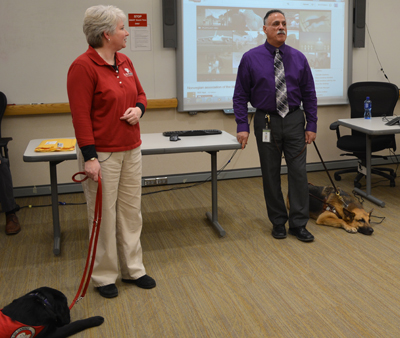
Laurie Carlson, volunteer coordinator for Can Do Canines, and Ken Rodgers, MnDOT's disability program coordinator, talk about the training and use of service animals to help people with disabilities. Their discussion was part of an hour-long event March 13 in Central Office sponsored by FUEL, the employee resource group whose mission is to expand all employees' knowledge of disabilities. Photo by Libby Schultz |
For those who work in MnDOT’s Central Office, Ken Rodgers and his guide dog, Havana, are a familiar sight as Rodgers goes about his duties as MnDOT’s disability program coordinator.
On March 13, he and Havana appeared before a room packed with MnDOT employees and gave them a peek into the world of training and using service animals to help people with disabilities. The “Fur, Fun, Facts: How Puppies Become Service Animals” program was sponsored by MnDOT's FUEL employee resource group.
Rodgers lost his eyesight as an adult and had to learn do everything differently than before--cooking, cleaning, travelling. Initially he thought he could get by using just a cane. It wasn't until he enrolled at The Seeing Eye in Morristown, N.J., and trained with his first guide dog that he realized what he was missing.
“The first time you can walk without that tentativeness…was like the first time I remember running, that feeling of exhilaration,” he said. “Our dogs give us independence to be fully who we are.”
Havana, a seven-year-old German Shepherd, is Rodgers' third guide dog. Although they've been together for five years, Rodgers says that he still has to correct Havana's behavior every day.
“They’ll test you like kids and some adults,” he said, noting for example that Havana will snap up dropped food any chance she can.
Service animals are on duty 24/7. Rodgers said it's okay to say "hi" to Havana ("and to me, too"). However, people shouldn't reach down to pet her because it distracts her from her job.
Guide dogs are trained to obey their owner's commands, yet they must also possess "intelligent disobedience" at times. Rodgers cited an example of his previous dog who would not let him cross a busy street even though they had done so at the same spot earlier. Finally, a stranger who was observing the interaction told Rodgers that he had "one smart dog," noting that there was a fence blocking the sidewalk across the street because of construction.
Laurie Carlson, volunteer coordinator for Can Do Canines, was also on hand to talk about her experience. She said there are five types of service dogs, each specializing in an area to assist individuals who have hearing loss, mobility issues, seizures, autism or diabetes. She said dogs will typically come into the program at 18 months and trainers will observe them to determine what their talents are.
"They have to want to do it," she said, noting one Corgi who was training to be a diabetes assist dog but wasn't persistent enough to do it. It's then that the trainers consider a "career change" for the animal to an area where it may be better suited. The Corgi, who liked to retrieve objects, became a hearing assist dog.
In the end, it comes down to this: “All dogs want to do is make their owner happy,” Rodgers said.
Click here for more information about FUEL and MnDOT’s other employee resource groups. |
 |
|

|
 |
TABLE of CONTENTS
 |
Third Avenue Bridge Project--Avoiding the Polar Plunge |
|
This video shows a demonstration of underwater sonar equipment used to see how much scour was affecting the 3rd Avenue Bridge in Minneapolis. Video produced by Bob Filipczak and Paul Pilarski. |
|
 |
|

|
 |
TABLE of CONTENTS
 |
On the Job: Amy Sanda helps employees lead healthier lifestyles |
By Rich Kemp
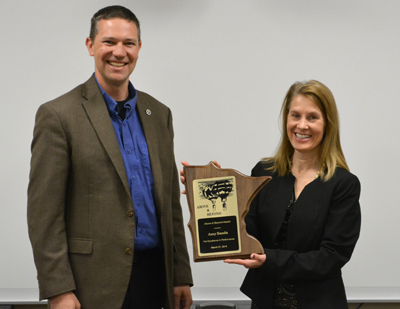
Eric Davis, chief of staff, presented Amy Sanda with an Above and Beyond Award for her contributions to the Central Office Health and Wellness Committee. Photo by Rich Kemp |
For 29 years, Amy Sanda has worked in the Geographic Information and Mapping - Cartographic Office creating municipal, county and street series maps. The maps include the printed state map, Light Rail Transit and the interactive GIS system maps that provide a wide range of information and data.
In addition to her work with the Cartography Office, Sanda has also carved out time to help keep MnDOT employees healthy. Last week she was recognized by Eric Davis, chief of staff, for her contributions to the Central Office Health and Wellness Committee, which she has chaired for the last 10 years.
“During Amy’s tenure as chair, the ‘employee-powered’ wellness committee successfully opened, operated and maintained an on-site fitness center, promoted several fitness classes, sponsored multiple events, and assisted thousands of state employees across the Capitol Complex to lead healthier, more productive lives,” said Davis, who presented Sanda with an Above and Beyond Award at the committee’s monthly meeting.
How did you get involved with the Health and Wellness Committee?
The committee asked if I would become part of their team since I was really enthusiastic about health and wellness.
What kind of a commitment is involved?
We meet once a month. Our team is really dedicated to helping with events and planning. Each member supports the committee and takes responsibility for a portion of the duties.
Why do you do this?
I enjoy encouraging employees to be healthy in the workplace! I am interested in nutrition and my interest in health is very broad. It’s nice to educate employees on so many different aspects – prevention, fitness classes, nutrition, etc. The committee also works with the cafeteria and vending machine providers to offer opportunities for employees to eat better.
Do you work with the districts on health and wellness?
The committee has encouraged the districts to start their own programs. It doesn’t have to be a lot - just sending out emails on nutrition or community health events. They can start a walking group. We also put a lot of helpful information on iHub for all employees.
What are some of the accomplishments of the committee?
Getting the Fitness Center up and running is the biggest accomplishment and being able to upgrade the equipment. We hosted several Brown Bags on health and wellness. The Run at Work Day and Commuter Challenge/Health Fair were also successful events.
Have MnDOT employees’ views on health and wellness changed during the past 10 years?
I’ve received positive feedback from many employees. They appreciate the new equipment in the Fitness Center and membership has increased in recent years. The number of participants in the Weight Loss Challenge has increased. It is good to see more and more people care about their health.
How can employees get involved with the committee or its activities?
If an employee wants to get involved, contact Jarvis Keys. The first step is to get your supervisors’ approval and think about what you can contribute to the committee.
Sanda emphasizes that the Health and Wellness website has helpful information for employees from around the state. The web page currently has health and wellness information with tips to help employees quit smoking and get better sleep.
Do you or a co-worker have an interesting job to share with readers? Click here to send us your ideas, and we’ll contact you for more information.
Recent employee profiles:
|
 |
|

|
 |
TABLE of CONTENTS
 |
These ‘engineers’ build bridges using toothpicks and glue |
By Beth Petrowske, District 1 Public Affairs
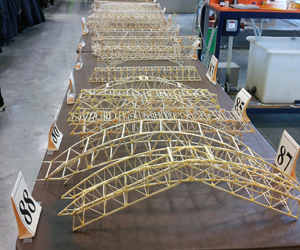
One-hundred twenty bridges were entered in Toothpick Bridge Building Contest that was held in the engineering department at the University of Minnesota Duluth. Photo by LeeAnn LaPlante |
The 21st Annual Toothpick Bridge Building contest was held recently in the engineering department at the University of Minnesota Duluth. The Duluth Chapter of the American Society of Civil Engineers hosted the event.
Hundreds of high school students from 12 regional schools designed and built bridges made of toothpicks and wood glue. Weight of the entries could not exceed 90 grams and the bridges had to span a distance of at least 55 centimeters.
Schools used a variety of criteria to determine which bridges advanced to the final competition at UMD.
John Hinzmann, District 1 Land Management supervisor, and Chris Morris, District 1 soils engineer, are members of ASCE and were involved with planning and facilitating the contest.
Morris has been involved with the toothpick bridge contest for more than 10 years. He visits schools prior to the contest to help introduce students to civil engineering concepts and teaches them about the different types of bridges.
“It’s surprising how many times I run into someone in the engineering community and they say, ‘I had you in toothpick bridges!’ and now they are civil engineers," Morris said.
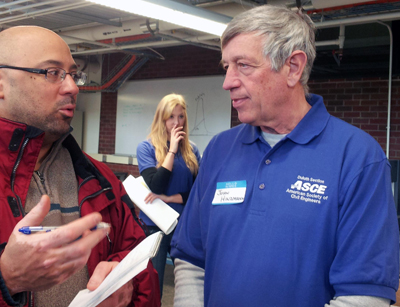
John Hinzmann, District 1 Land Management supervisor, is interviewed by a reporter from the Duluth News Tribune during the Toothpick Bridge Building Contest that was held in the engineering department at the University of Minnesota Duluth. Photo by LeeAnn LaPlante |
The contest exposes students to an application that involves physics, geometry and engineering and challenges them to think creatively.
One-hundred twenty bridges were weight-tested to failure during the contest. The bridges were tested by adding scoops of sand to a bucket supported by the bridge. When the bridge collapsed, the bucket was weighed to document how much weight the bridge held.
Anthony Schultz and Kenneth Morris of Bayfield, Wis. won the Strongest Bridge category with a bridge that held 167 pounds.
Ariel Pierre and Michael Wachsmuth, Bayfield, built a 30-gram bridge that held 29 pounds to win the Most Economical category. The prize goes to the lightest bridge to hold 10 kg of weight.
Sierra Offersen of Hermantown, Minn., won the top award in the Most Aesthetically Pleasing category.
The contest started 20 years ago as a fun way to introduce students to engineering.
This video clip shows a toothpick bridge being weight-tested. Each student tested their own bridge. This bridge withstood the weight of 32 pounds before collapsing. Video produced by Beth Petrowske |
|
 |
|
| |
|



